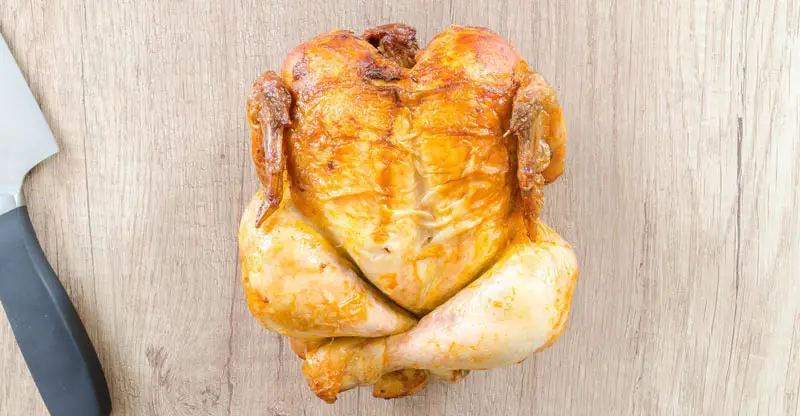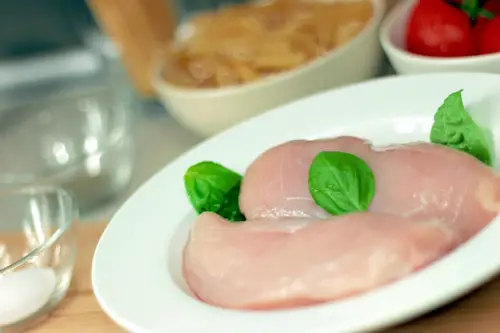It's a widely known fact that any meat product left out for a lengthy period of time is no longer safe to consume.
There are many ways to defrost and store our food with some being better than others, of course. But it all comes down to the amount of time in which the chicken stays at a temperature above 40 degrees Fahrenheit that makes all the difference.
A quick web search shows there are a variety of issues that can lead to negative effects on our health if the chicken sits out at room temperature. Deciding to eat these foods can be detrimental to our health. Facts often change with the ever-growing research done to help us, the consumer, eat safely.
Can you pinpoint a time in your kitchen when you took chicken out only to get distracted by another task?
Then you either forgot to cook it, or maybe your meal plan changed. Sometimes you can just plain forget to put it back in the refrigerator. The common solution here is to take precaution in deciding the best way to deal with the left-out chicken.
So what are the details behind the question of whether or not to eat it?
Do you know how long to wait before you can put food in a new refrigerator? Read our expert advice on the subject here.
Perishable Foods
Chicken, among many other foods, falls under the perishable foods category. This means that if left out at room temperature, it will begin to grow bacteria at an alarming rate, leading to a whole lot of health concerns.
The temperatures at which perishable foods can remain stable are those of refrigeration temperatures, or 40 F° (4.4 °C) or frozen at 0 F° (-17.8 °C). Otherwise, if not kept in these cool conditions, the food will start to rot or spoil — and quickly.
There are a variety of bacterial strains that grow on perishable foods.
Pathogenic bacteria are one of the biggest concerns when it comes to perishable foods. This is the most common bacteria that can lead to foodborne illnesses. It is often the bacteria that we hear of in the news that wreaks havoc on food supplies and has a reputation for hospitalizing consumers.
Signs of this type of pathogenic bacteria can leave the food smelling and taste foul and sour.
You may also like: All You Need to Know About Healthy Non-Perishable Food
Raw Chicken vs. Cooked Chicken
The rule of thumb for cooked chicken is if it is out longer than two hours at room temperature — beware.
The bad pathogenic bacteria can start to grow quickly and can lead to food poisoning or any other food-related sickness. According to the USDA, it is best to throw the food away if out past the two-hour mark. And do not try to reheat a cooked chicken meal if it has sat out overnight.
The extra heat from the microwave or stove will not kill the bacteria once it has started forming. One common strain of bacteria known as staph or staphylococcus, forms a heat barrier making it nearly impossible to kill with added heat. So that is clearly not an option.
The same rules apply to thawed raw chicken. If you leave the chicken out past the two-hour mark, throw it out or face the consequences.
The raw chicken itself is already full of bacteria strains that are normally killed off during cooking. If the raw chicken is sitting out uncooked, imagine the growth rate of the bacteria in 30 minutes at room temperature on the kitchen counter. You definitely don’t want to have a microscope over it.
Thawing Chicken
Chicken is one of the most commonly consumed meats.
If you are reading this article, you have more than likely experienced thawing your chicken on the countertop while you left for work. Only to come back to find the chicken has a foul smell and a slimy texture. Then the question starts to arise about where the process went wrong.
Many people choose the counter method as their thawing option. Yet, frozen chicken on a countertop holds the same risks of growing unhealthy bacteria at an exponential rate at room temperature.
To safely thaw chicken refrain from leaving it to defrost longer than 24 hours. Thawing chicken requires removing it from the freezer and placing it in the refrigerator the night before you cook.
Along with countertop defrosting, you should also avoid microwaving or thawing chicken in a bowl of water. If you choose one of these quick methods as soon as the chicken has almost completely thawed, cook it immediately. Never use the quick methods for a meal you choose to cook the next day.
Final tips
If you have ever defrosted chicken and decided you no longer want chicken or have a change of plans, never refreeze thawed chicken. Also, you never want to store cooked food near raw food. Meaning, if you only cooked some of the defrosted chicken, don’t store that dish next to the raw meat.
Once you have reheated a chicken dish once, throw the leftovers away. Reheating and cooling more than once will increase the chances of harmful bacteria growing on your food.
The best option for meat leftovers is to freeze them in portions. This ensures you are only defrosting the amounts needed for your preferred servings.
Last but not least, if you have found that you consumed spoiled chicken, stop consuming immediately. Campylobacter illness is the second leading cause of food poisoning. It originates from raw chicken juice.
Some symptoms to watch for on most food-related illnesses are:
- vomiting
- cramps
- fever
- diarrhea
Symptoms may show anywhere between a few hours to a couple of days. The rate at which symptoms arise all depends on the digestive system of the person.
Conclusion
No matter how much you love chicken, nothing is more important than your health.
Be aware of the health risks that come with consuming raw or over thawed chicken. Cook thawed meats immediately and always cook thoroughly.
Store and freeze leftovers carefully to avoid contamination or possible food bacteria illnesses. Defrost safely in the refrigerator and always keep cooking areas clean and raw food away from fresh foods.
Remember to consume reheated leftovers and never try to refreeze or save reheated leftovers. Enjoy your chicken safely and always cook following the safety tips provided in this article. No one likes spoiled chicken!
Need new recipe ideas?



